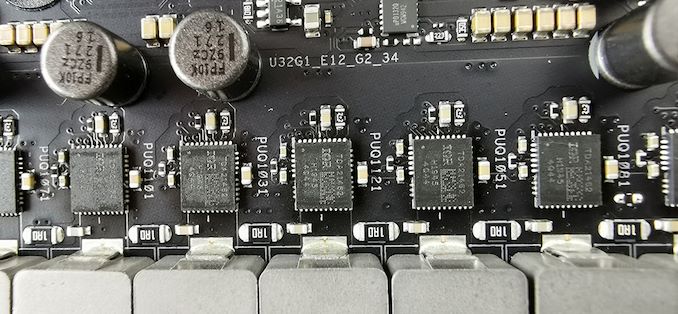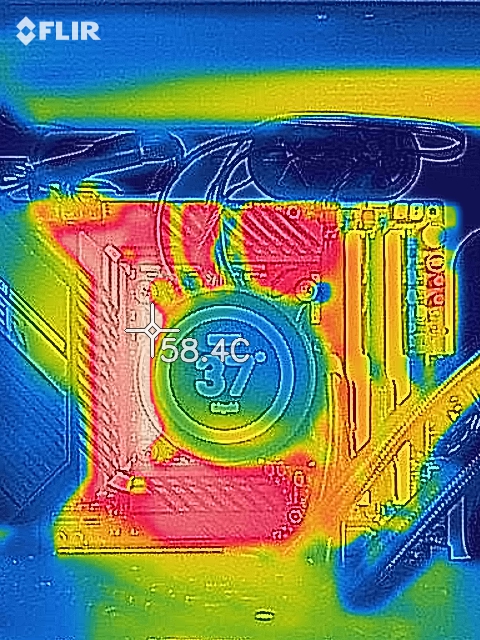ASUS ROG Maximus XII Hero Wi-Fi Review: The Tale of Two Motherboards
by Dr. Ian Cutress & Gavin Bonshor on June 11, 2020 11:45 AM EST- Posted in
- Motherboards
- Intel
- Asus
- ROG
- 5GBase-T
- Z490
- 10th Gen Core
- Comet Lake
Power Delivery Thermal Analysis
A lot more focus has been put onto power delivery specifications and capabilities, not just by manufacturers, but as a result of users demands. In addition to the extra power benefits from things like overclocking, more efficient designs in power deliveries and cooling solutions aim to bring temperatures down. Although this isn't something most users ever need to worry about, certain enthusiasts are bringing more focus onto each boards power delivery. The more premium models tend to include bigger and higher-grade power deliveries, with bigger and more intricate heatsink designs, with some even providing water blocks on ranges such as the ASUS ROG Maximus Formula series.

The ROG Maximus XII Hero WiFi uses a 16-phase design in 7+1 mode, with TDA21490 90 A Power stages
Testing Methodology
Our method of testing out if the power delivery and its heatsink are effective at dissipating heat, is by running an intensely heavy CPU workload for a prolonged method of time. We apply an overclock which is deemed safe and at the maximum that the silicon on our testbed processor allows. We then run the Prime95 with AVX2 enabled under a torture test for an hour at the maximum stable overclock we can which puts insane pressure on the processor. We collect our data via three different methods which include the following:
- Taking a thermal image from a birds-eye view after an hour with a Flir Pro thermal imaging camera
- Securing two probes on to the rear of the PCB, right underneath CPU VCore section of the power delivery for better parity in case a probe reports a faulty reading
- Taking a reading of the VRM temperature from the sensor reading within the HWInfo monitoring application
The reason for using three different methods is that some sensors can read inaccurate temperatures, which can give very erratic results for users looking to gauge whether an overclock is too much pressure for the power delivery handle. With using a probe on the rear, it can also show the efficiency of the power stages and heatsinks as a wide margin between the probe and sensor temperature can show that the heatsink is dissipating heat and that the design is working, or that the internal sensor is massively wrong. To ensure our probe was accurate before testing, I binned 10 and selected the most accurate (within 1c of the actual temperature) for better parity in our testing.
To recreate a real-world testing scenario, the system is built into a conventional desktop chassis which is widely available. This is to show and alleviate issues when testing on open testbeds which we have done previously, which allows natural airflow to flow over the power delivery heatsinks. It provides a better comparison for the end-user and allows us to mitigate issues where heatsinks have been designed with airflow in mind, and those that have not. The idea of a heatsink is to allow effective dissipation of heat and not act as an insulator, with much more focus from consumers over the last couple of years on power delivery componentry and performance than in previous years.

ASUS ROG Maximus XII Hero WiFi undergoing our VRM thermal testing (We test with the side panel on)
For thermal image, we use a Flir One camera as it gives a good indication of where the heat is generated around the socket area, as some designs use different configurations and an evenly spread power delivery with good components will usually generate less heat. Manufacturers who use inefficient heatsinks and cheap out on power delivery components should run hotter than those who have invested. Of course, a $700 flagship motherboard is likely to outperform a cheaper $100 model under the same testing conditions, but it is still worth testing to see which vendors are doing things correctly.
Thermal Analysis Results

We measured 58.4°C on the hottest part of the PCB around the CPU socket and power delivery
The ASUS ROG Maximus XII Hero WiFi is equipped with a 16-phase power delivery with fourteen Infineon TDA21490 90 A power stages for the CPU, and two TDA21490 90 A power stages for the SoC. The power delivery is controlled by an ASP1405I 8-phase controller operating at 7+1, as ASUS is using teamed power stages for better efficiency, more consistent power throughput, and improved transient response. The Maximus XII Hero WiFi is using three heatsinks to cool the power delivery which is all interconnected via a nickel-plated copper heat pipe, with deep grooves in the aluminium fins designed to channel passive airflow.
Focusing on the thermal performance, the ASUS ROG Maximus XII Hero WiFi power delivery operates well within the guideline specifications of each part when subjected to our test method. We measured 58°C from the integrated VRM thermal sensor on the board, with a matching reading of 58°C from our first thermal probe. We saw a bit of variance compared to our second probe which we measured at 52°C, although we did pick up another consistent reading of 58.4°C from our FLIR thermal imaging camera.
Compared to the other models on test, it leaves us no doubt that the ROG Maximus XII Hero WiFi has plenty to offer for overclocks, with lots of potential headroom left. The ASRock model is running cooler due to its active cooled power delivery heatsink, but the GIGABYTE currently wins out in our power delivery thermal testing with its design.











29 Comments
View All Comments
Carlos_MaximaReview - Sunday, July 12, 2020 - link
At Maxima Review we hit 5.4 GHz over the air with the MSI ACE and a 10900K. If you do not believe you can visit us on the web, apart from facebook we also have a video to prove what I say. Greetings to Anandtech we are always in tune with your Review. Greetings from afar.AnnaSmith - Monday, July 20, 2020 - link
Glad to be here on your great site. https://federalprocessingregistry.comnatashadipth - Monday, August 3, 2020 - link
Is it accurate to say that you are searching for the best electric cutting tool?https://electricchainsawworld.com/ This rundown will assist you with picking the great one since it's a troublesome errand to choose which one is incredible as there are a ton of brands in the market offering their items, yet our surveys incorporate just first class cutting tools.sonyaroy690 - Thursday, August 20, 2020 - link
I am really looking forward to buying one but unable to find its detailed video review.https://bestblackfridaydeals.net/
AnnaSmith - Wednesday, September 2, 2020 - link
Awesome information you've shared here. https://www.wescoopthepoopokc.com/annaflux - Monday, November 30, 2020 - link
I am planning to make a new system for my office to perform some very basic stuff like posting content on https://bestbuysteamcleaners.com/ and a few other blogs along with using Adobe application. What should b e an ideal specifications for such computer?sonyaroy - Thursday, December 3, 2020 - link
I switched my system from ASUS ROG Maximus XII to msi meg z490 godlike and found much better results. http://zshadow.info/Tom Sunday - Tuesday, December 29, 2020 - link
Looking for Mobo deal at the computer show this past weekend the boys from Varanasi told me that Z490 buyers have been experiencing 'unsolvable' problems in getting their LAN to work. ASUS cannot help and is basically all talk. Not even a new BIOS update, driver hotfixes and new cables will help. Even INTEL updated drivers are not working. It appears that there are problems with the I225-V (LAN Chip) and Asus want to keep this issue hushed. Simply this being a hardware problem and no software or driver updates can permanently fix it. What has been done to date is only bandaging the problem. Many new Mobo purchaser's in frustration (disconnected their onboard NIC) and installed a new PCIE NIC and gotten it to work without a hitch! But its another $50 or so out of pocket to simply forego the downtime, hanging on the telephone and difficult RMA's. Will the new Z590 Mobo's in early 2021 get a new NIC chip? Anyway, the best advice is probably to stay away from purchasing any (2020) Z490 leftover boards using the embedded I225-V Ethernet controller and buy in a few weeks time a Z590 MOBO if INTEL is ones choice. Any Thoughts?Tom Sunday - Monday, January 18, 2021 - link
Hanging around our local strip center PC shop I found that many were looking to snatch Z490 Asus mobos on sale, now that the very expensive Z590's have been announced. But the word was still that ASUS Prime, Hero and the entire Strix lineup still maintain to have (Ethernet) LAN issues. Supposedly Asus has introduced a reissue of the boards with an actual LAN hardware replacement? Previous Bios updates and hours playing with new and old drivers never worked. But Amazon as late as this past December is still issuing RMA's and selling these boards with no LAN fixes. Looks like many such boards are still on the shelves with these problems. How do I differentiate a Hero board which apparently has the hardware Lan fix? I checked Gigabyte at Amazon and found none of these LAN issues among the certified buyers. I have been using Asus mobos for a long time but now the story goes on...what's the scoop? WTF!